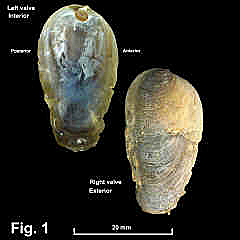|
|
VULSELLIDAE |
|
|
|
Vulsella minor Röding, 1798 Description: Shape variable, elongate to ovate; circular when juvenile, becoming elongate with growth. Hinge with a triangular ligamental area divided by a triangular pit with semicircular chondrophore below. Interior fawn or purple-black, nacreous in middle with a wide non-nacreous margin. Exterior with earliest growth smooth, then irregular concentric ridges crossed by dense, beaded radial ribs. Periostracum thick, smooth, brown, usually eroded off. Shell colour variable; irregularly coloured fawn, brown or purple-black. Size: NSW specimens up to 45 mm in height. Distribution: In Australia, from NSW southwards to south-western WA, including Tas. Habitat: Lives embedded in sponge with only the ventral edge showing. Macpherson & Gabriel (1962) reported that in Victoria clumps of sponge as big as a fist that had washed up on the shore could contain up to two dozen individuals. Comparison: This species is similar to the tropical species Vulsella vulsella (Linnaeus, 1758), which occurs in northern Australia and possibly in northern NSW. It is larger than V. minor and, when shells are not eroded, shows longitudinal brown lines that are not evident in V. minor. Synonymy: Vulsella spongiarum Lamarck, 1819 has been the name usually used for this species over the last century. Remarks: Roberts (1984) reported on the ecology and reproductive characters of this species in Princess Royal Harbour, south-western WA. Fig. 1: Simpsons Beach, Bundeena, Port Hacking, NSW (C.436044) |
|
